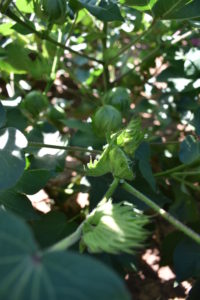System Maintenance
 The performance and life of any subsurface drip irrigation system depends on how well it is operated and maintained. Whether automatically controlled or otherwise, D&H recommends that farmers inspect their system regularly and perform system maintenance. The filtration back-flush system needs to be well maintained and the laterals flushed at regular intervals. Clogging is also not readily apparent, so it may be wise to choose acid solutions and/or chlorine to boost flushing effectiveness. Cleanout valves installed at the end of the tube lines are important to remove blockages and draining the system.
The performance and life of any subsurface drip irrigation system depends on how well it is operated and maintained. Whether automatically controlled or otherwise, D&H recommends that farmers inspect their system regularly and perform system maintenance. The filtration back-flush system needs to be well maintained and the laterals flushed at regular intervals. Clogging is also not readily apparent, so it may be wise to choose acid solutions and/or chlorine to boost flushing effectiveness. Cleanout valves installed at the end of the tube lines are important to remove blockages and draining the system.
Regular baseline readings and monitoring of flow, pressure and flush water condition will guide maintenance scheduling. In addition to flow, pressure and condition of flush water, the overall condition of the pump station and distribution system, including control equipment engines, motors, reservoirs, injectors, pipelines, valves, fittings, flow meters and pressure gauges, should be routinely inspected and/or calibrated. Broken or dysfunctional equipment should be immediately repaired or replaced with the same or similar equipment that will perform the same function according to system design criteria.
Automation will pay for itself by reducing labor requirements and by enabling more precise irrigation. Since subsurface drip is a relatively permanent system, it lends itself very well to automation. D&H installs systems with basic instrumentation that starts with meters to help monitor system performance and help diagnose potential problems. Placing flow meters at strategic locations such as at submains for system monitoring provide feedback for irrigation control and adjustment. Pressure gauges are also vital in an SDI system to monitor pressure and to help diagnose problems. Low pressure and/or increased flow rates during normal operation can indicate a leak.
Automation of irrigation continues to provide increased control and productivity. D&H subsurface drip irrigation systems transmit data to a tablet or smartphone to provide timely information to the farmer. Automatic alerts can be sent to a mobile device when one of systems is not operating properly. Farmers can then use the devices to assist with management decisions such as monitoring the amount of water supplied to the crop or turning off their systems during a rainstorm. Manipulating the following operations from a tablet or smartphone may save the farmer a trip to the field.
- Turn system on and off
- Open and close drip zone valves
- Adjust operating pressure
- Monitor rainfall with an automatic recording rain gauge
- Increase and decrease water flow
Upon completion of the installation, D&H educates their customers on the system flow of water and how the system works. They provide a complete onsite tutorial to each customer. And because they realize that this is a huge of information to process and remember they also supply instructional cheat sheets for future reference. When problems arise, the issue can be quickly solved. Often the problem can be discussed by phone and repaired while talking to D&H technicians eliminating the need for a site visit.